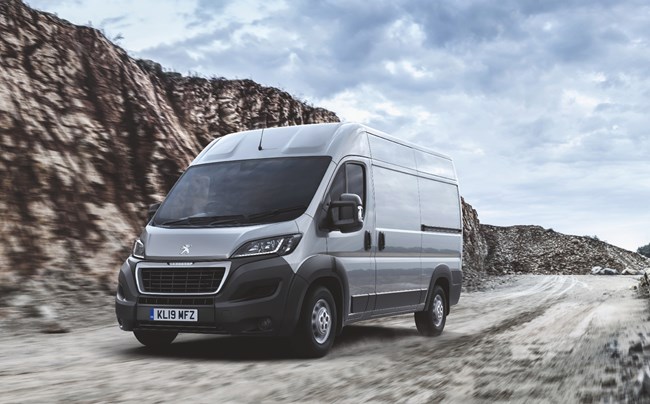- Remarketing: Pick of the bunch
- GA Commercial acquires first vans through Vanaways
- 'Luxury' tax on expensive pick-up trucks suggested
- ADVERTISEMENT FEATURE: Essential advice to avoid the van fleet ICE-berg
- ETRUX launches new Ford E-Transit Trizone
- Renault gives UK debut to Master E-Tech at CV Show
- Isuzu D-Max long-term test – Latest Report
- Isuzu D-Max V-Cross Steel Edition revealed
- IVOTY Report: Stellantis explores the hydrogen proposition
- New Maxus EVs include eDeliver 5 van
Buying a used... Peugeot Boxer (2014)
Date: Friday, October 28, 2022 | Author: Ian Shaw
The Peugeot Boxer has been around for some time, but still offers good productivity.

The Peugeot Boxer can trace its origins back to 1981 and the birth of a partnership between Citroen-Peugeot and Fiat. This produced the Ducato for the Italian brand with Peugeot using its existing designations to call its version the J5. We saw it in the UK as the Talbot Express too. Once the new Sevel models broke cover in 1993, Peugeot used the Boxer name, identical to its Citroen Relay twin and differing only in engine type from the Sofim-powered Fiat Ducato. The third generation of the breed came in 2006 with a facelift in 2014. Peugeot adds them up to call it the fifth generation, but basically this is a 2006 model type. During that time plenty of newer vans have hit the market but Stellantis – which formed in 2021 by PSA buying Vauxhall-Opel – will keep it going until the new full-EV platform hits the streets.
However, do not write the Boxer off as over the hill, it has always had two main strengths; myriad body variations and strong economical engines, which explains why it’s probably appealed to fleets more than sole-traders over the years. It’s available in four lengths giving overall dimensions of 4.9, 5.4, 5.9 and 6.3m on three wheelbase lengths of 3, 3.4 and 4m, the longest body (L4) gained from a greater overhang on 4m wheelbase shared with the L3 version. All are 2.5m across the mirrors and heights are 2.25, 2.5 and 2.75m. Load lengths are 2.67, 3.12, 3.7 and 4.07m. The three roof heights give 1.66, 1.93 and 2.17m with load bay width being 1.86m at best, and 1.42m between the wheelarches. All that equates to volumes of 8, 10, 11.4, 13, 15 and 17m3, accessed by twin rear doors and single side door of 1.5 and 1.1m wide respectively.
Gross weights range from 3 to 4t, with payloads from 1,155kg to 1,575kg in the 3.5 tonnes versions – some of the best in the class.
So, what about the engines?
The power outputs look moderate beside the BiTurbo contenders, which have come along since, but the torque spread is even, its longevity well-proven and economy impressive.
The 2l ‘blue’ HDi from 2016 covered 100 to 150hp, but these engines only saw a three year life span before it was up to 2.2l with Euro 6D regulations for 2019. Power outputs remained moderate at 120 or 140hp with torque of 310 and 350Nm respectively. Not big numbers and the Boxer is no ball of fire on the road, but it has that flat torque plateau, which gives 26 to 35mpg on the official figures for the 120hp unit with only a one-mpg fall-off for the 140hp lump.
Equipment levels are decent in later 2020-onwards models with cruise control and sat-nav on the top ‘Professional’ trim, and enhanced traction-control on the ’Grip’ version. Visibility is great and the cab feels spacious, but old and noise levels are quite high. No, it’s not ‘car-like’, but it sure is van-like. What matters to you?
Five best options
1) 2.2-litre 140bhp engine
2) Professional trim
3) Asphalt trim
4) Grip trim
5) LWB
Five best avoided
1) 2.0-litre engines
2) L4
3) ‘S’ trim
4) SWB
5) Low roof
Second-hand buys
|
Version |
Plate |
Year |
Mileage |
Price ex.VAT |
|
L3H2 2.2HDi |
18 |
2018 |
103,000 |
£9,995 |
|
L3H2 2.2HDi |
19 |
2019 |
68,700 |
£14,695 |
|
L4H2 2.2HDi |
20 |
2020 |
62,000 |
£15,995 |
|
L3H2 2.0HDi |
21 |
2021 |
42,000 |
£19,500 |
|
L3H2 2.0HDi |
22 |
2022 |
99 |
£25,950 |
View The WhatVan Digital Edition


